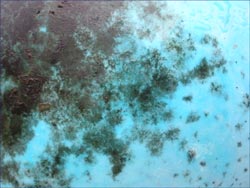 Have you recently noticed a little patch of black mold growing on the ceiling of your bathroom? Rather than wondering about how you are going to remove it, your first question should be "is black mold dangerous?" Here are three points that you need to know about the presence of mold in your home.
Have you recently noticed a little patch of black mold growing on the ceiling of your bathroom? Rather than wondering about how you are going to remove it, your first question should be "is black mold dangerous?" Here are three points that you need to know about the presence of mold in your home.
Mold can involve larger areas and can be a big problem. If you need to remove or clean mold, you want to see the articles 'How To Remove Moldy Drywall?' and 'How To Disinfect Moldy Drywall'.
Check out this government website before you mess with mold. A Brief Guide to Mold, Moisture, and Your Home, it will give you some insight and safety tips. Another good article is Mold, on the CDC website. The EPA states that repairs of less than ten square feet can be performed by a homeowner, as long as they follow the guidelines.
DID YOU DO SOMETHING WRONG?
The first thing you need to know about mold growing in your home is that it didn't occur because of something you did or didn't do. Mold spores move through the air, and can easily enter the home through any opening. They could have easily wafted in on the breeze when you were carrying your groceries in from the car, or piggybacked in on the fur of your pet.
Once inside the home, if mold meets the right growing conditions, then the spores will begin to reproduce and grow bigger colonies. It can take as little as 48 hours for mold to begin growing if it hits just the right spot.
WHAT DOES MOLD NEED TO GROW?
So what are the right spots for mold to grow? The three main ingredients that mold needs to grow are food, moisture, and humidity. When it comes to moisture, there is a ready supply of that already in your home. From the steam that is created by your hot showers, to that insignificant leak dripping from your pipes, the first item mold needs is not hard to locate.
Bathrooms are one place where mold can grow rapidly due to the heat that is generated in there. If you are not regularly using your ventilation fan, the heat from the shower steam has nowhere to go. This builds up until the air molecules are filled with water, and this is the cause of your humidity.
As for food, the particle board that is covering your bathroom walls and ceiling is all the food mold spores need. These products are made from cellulose materials which contain sugar. Mold has a sweet tooth, so fiber boards, wallpaper, and wood particles are all the perfect diet for your mold.
WILL THE PRESENCE OF MOLD CAUSE ILLNESS?
Now that you have noticed the problem growing in your bathroom, it is time to answer the question of "is black mold dangerous?"
The short answer to that question is yes, it can be.
The problem with black mold is that it does not affect the health of every person in the same way.
Some people may not experience any direct reactions from being exposed to black mold. But those who are sensitive to allergies, have respiratory illnesses such as asthma, or who are very young could be susceptible to bigger problems.
Medical reactions that may occur after being exposed to black mold include skin irritation, breathing issues such as wheezing, runny noses, and irritated eyes. Prolonged exposure to mold by those already sensitive to it could result in a constant shortness of breath, or lung infections.
Once mold has been noticed in the home, it needs to be removed immediately. For all of the mold that you can see, there may be more lurking beneath your wall or ceiling coverings that you cannot see. If you feel the health of a home dweller is being affected by black mold, then you must remove them from the home until the mold is completely removed. Respiratory problems can quickly develop into severe medical conditions, so it is not worth the risk of prolonged exposure.
Testing Moldy Drywall
You may be concerned that the mold that you have is the dangerous 'black mold' that everyone is afraid of. There are many thousands of types of mold that you could have in your home. Only a few of them are toxic and not all of the toxic ones are black.
There has been overactive use of scare tactics with regard to mold. Some of this comes from the media, and some of it comes from companies that want to sell expensive remediation services.
How can you tell what type of mold you have? You cannot tell by the naked eye. The only way to tell is to have it tested. With that said, testing can be expensive.
There are some relatively inexpensive test kits that can tell you whether or not you have a dangerous problem. You can find 'Test Kits' for purchase at the 'My Mold Detective' website. If you want to put your mind at ease, test the mold before you attempt to clean or remove it.
Conclusion
So is 'black mold' dangerous? It can be, but many times it is not. However, it is dirty and smelly so getting rid of it makes sense. See the articles 'How To Remove Moldy Drywall?' and 'How To Disinfect Moldy Drywall'.

